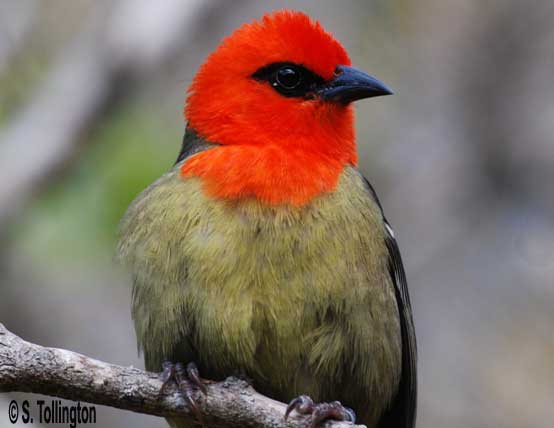|
 Mauritius Fody Foudia rubra Mauritius Fody Foudia rubra
IUCN status: Critically Endangered in 1994, downlisted to Endangered in 2009.
|

Male Mauritius Fody
|
Fast facts
- a small forest-dwelling songbird
- the male has bright red plumage from head to chest and an orange patch on the rump during the breeding season, the female is a uniform olive-brown with darker wings
- very similar to the introduced and very common Madagascar Fody but during the breeding season the male Madagascar Fody has a completely red body, also the introduced species has a thick bill for eating seeds whereas the endemic species has a thinner bill to probe for insects
- in addition to insects their diet also consists of fruit and nectar
- known in French as cardinal de Maurice
- approximately 14cm in length
|
|
|

Female Fody
|
| |

The rescue of chicks from nest
|
| |

Fody day1-2
|
|
|
The Mauritius Fody, a small endemic songbird, was once common in the forests of Mauritius. Over time, numbers declined due to habitat loss and nest predation, and it became restricted to a small range within the Black River Gorges.
Efforts to conserve this charismatic species began in the late 1990s, and marooning on predator-free offshore islets was deemed the best strategy to establish additional sub-populations and to ensure the future survival of the species. By 2002/3 it was believed that just 98-126 wild pairs remained.
The rescue of chicks from nests for hand rearing and subsequent reintroduction started in 2002 and by 2003 the first releases of Mauritius Fodies were carried out on Ile aux Aigrettes. This reintroduction was a great success, and the birds were already breeding by 2004. Captive breeding of this species was also initiated at Gerald Durrell Endemic Wildlife Sanctuary during this time.
The population is closely monitored, and has grown to 55-60 breeding pairs and over 165 birds, combined with the wild population in the gorges this brings the total to around 400 birds. In May 2009 the IUCN Red List status of the Mauritius Fody was lowered to Endangered. Although this is a postive step, the numbers and range of the fodies are still very small, and efforts must continue to increase the number of birds.
Monitoring and management of the Ile aux Aigrettes population is ongoing and is vital in enabling us to plan the future management of this species. Data collected has shown that as the number of birds on the island has grown, the territory size and breeding success has diminished. This indicates that the island is now at its carrying capacity for this species, and provides useful information for planning future translocations.
In 2010, Mauritius Fodies were released to Round Island, with the aim of establishing an additional sub-population. Unfortunately, due to a variety of reasons, including predation by Keel-scaled Boas, only one individual survived. There are no active plans for further translocations to Round Island or other islands currently, although suitable locations will continue to be investigated.
Ongoing work on the Black River Gorges population will involve surveys and the mapping out of the fody's territory, with the aim of establishing population numbers more precisely. Monitoring and management of the island population will contine, concentrating on breeding activity and the collection of feeding data.
|
|
|
|
|
|